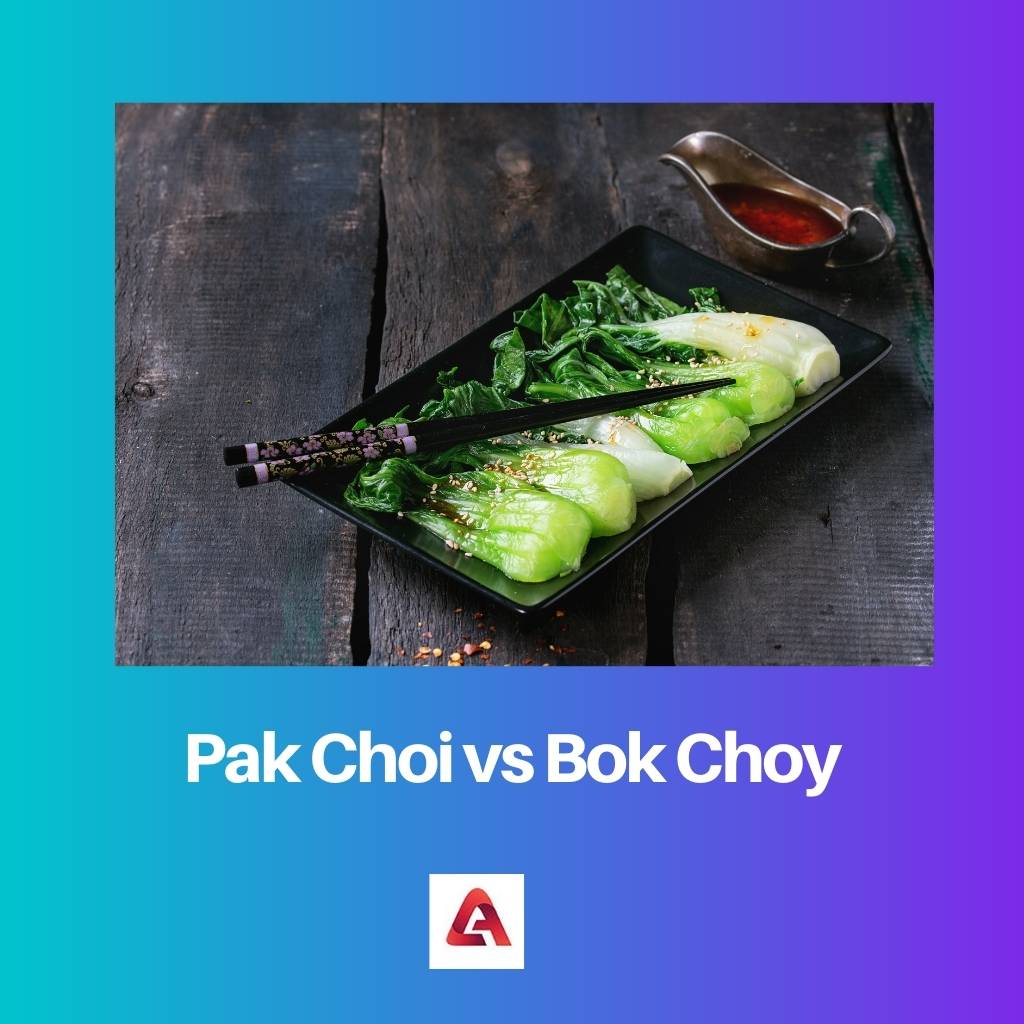There exist some things which are known differently in different places. The names differ from place to place. Language is a very funny thing.
However, we will trace the differences between the words Pak choi and bok choy. Bok choy or Pak Choi is a leafy green Chinese cabbage that’s native to Asia.
Key Takeaways
- Pak choi and bok choy are members of the cabbage family and have similar nutritional profiles, with high levels of vitamins A and C.
- Bok choy has a thicker stem and larger leaves than pak choi, with thinner stems and smaller leaves.
- Pak choi is used in stir-fries and soups, while bok choy is commonly used in Chinese cuisine and is a staple in dishes like hot pot and dim sum.
Pak Choi vs Bok Choy
The difference between Pak Choi and Bok Choy is that pak choi is used to name the leafy vegetable cabbage in Britain. However, Bok Choi is a popular terminology in the United States. Although both terms refer to the same vegetable, they are called differently in different places. One is a British spelling. On the other hand, another is the American spelling.

Pak choi is how it’s known in the United Kingdom. Pak choi and bok choy are two alternative names for the same Chinese cabbage-like leafy green vegetable with white stems.
Bok choy is the American spelling of the same leafy vegetable with white stalks. Pak choi and bok choy are two alternative names for the same Chinese cabbage-like leafy green vegetable with white stems.
Comparison Table
| Parameters of Comparison | Pak Choi | Bok Choy |
|---|---|---|
| Spelling | British spelling | American spelling |
| Place of use | Britain/ United Kingdom | United States of America |
| Scientific name | Its scientific name is Brassica rapa subsp, Chinensis | Brassica rapa subsp is the scientific name. |
| Subspecies | It belongs to Brassica rapa | The subspecies is Brassica rapa |
| Energy | 54 kJ (13 kcal) | 54 kJ (13 kcal) |
What is Pak Choi?
Pak choi is a leafy green Chinese cabbage native to Asian countries. It is also known by the names Chinese white cabbage, pe-tsai, white celery mustard, and pets.
On the other hand, the green petiole variety contains the Chinese pak choi green and mei qing Choi. Pak choi is a tiny plant that can reach a height of 12 to 18 inches.
There is no chance of gaining weight after consuming this cabbage. Instead, it aids your body in burning your current calories, resulting in weight loss. It also contains a lot of vitamins, minerals, and nutrients.

What is Bok Choy?
Bok choy is similar to Pak Choi. However, it is exclusively known by that name in the United States. Antioxidant properties are found in bok choy.
Bok choy contains more vitamin A and carotene than other vegetables in its family, such as cabbage and cauliflower. Eat 100 grammes of pak choi to get the recommended amount of vitamin.
This green and leafy vegetable contributes to the sweet flavour and crunchy texture. Pak choi can also be used in your regular cabbage coleslaw recipe.

Main Differences Between Pak Choi and Bok Choy
- These are grown abundantly in China, the Philippines, and Vietnam in the Asian region.
- Intake of Pak choi and bok choi are both full of essential nutrients contributing to health benefits as they are rich in Vitamin K, Vitamin C, Iron, Calcium, and many antioxidants.

- https://journal.unnes.ac.id/nju/index.php/biosaintifika/article/view/8537
- https://www.sciencedirect.com/science/article/pii/S0925521417311043

This article enhances knowledge about the geographic origins and various uses of Pak choi and Bok choy.
I agree. The cultural significance and culinary applications are well explained.
Yes, it gives a well-rounded understanding of these vegetables.
The detailed description of Pak Choi and Bok Choy is very informative.
I couldn’t agree more. It’s a great resource for anyone interested in understanding these vegetables.
Very interesting article. It’s good to know the difference between these two. Thanks for sharing this information.
I completely agree, It was very informative and well explained.
The comparison table is quite helpful in understanding the differences. I appreciate the effort put into this article.
Yes, the parameters of comparison give a clear idea about the distinct characteristics of each type.
I completely agree. The scientific and geographical differences are very well-highlighted.
The insights into the scientific and nutritional aspects are truly commendable.
Absolutely! It’s a comprehensive analysis of the differences and benefits of these vegetables.
This is such a thorough comparison. The details are excellent and very educational.
This article is a valuable resource for understanding the nutritional and health benefits of these leafy greens.
Exactly. It’s a commendable effort in presenting such comprehensive information.
The detailed comparison and references provided in the article make it an enriching read.
I couldn’t agree more. It’s an exceptional compilation of data and facts.
The geographical and scientific details in the article shed light on the variations between Pak choi and Bok choy.
The article is an excellent repository of knowledge on these leafy greens.
The article provides excellent insights into the nutritional content of Pak choi and bok choy.
Absolutely! It’s invaluable information for making informed dietary choices.